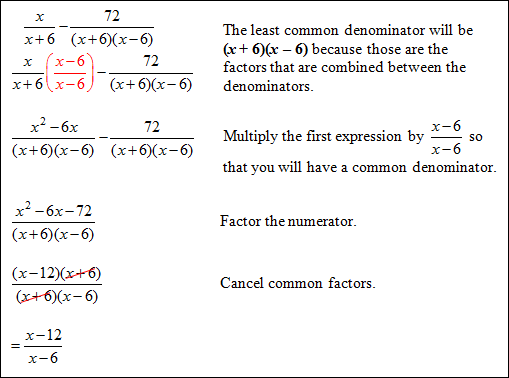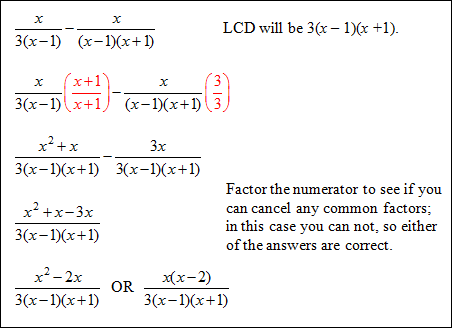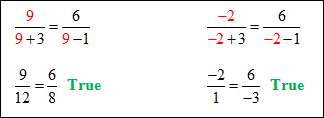PDF
RATIONAL EXPRESSIONS AND EQUATIONS
Unit Overview
In this unit you will learn how to multiply, divide, add, and subtract rational expressions. You will also simplify rational expressions. The unit concludes with solving rational equations.
Simplifying Rational Expression
A rational expression is in simplest form when its numerator and denominator are polynomials that have no common divisors.
| *factor the numerator and denominator |
| |
| *cancel any common factors |
|
Example #1: Simplify  . .
|
Stop! Go to Questions #1-3 about this section, then return to continue on to the next section.
Multiplying and Dividing Rational Expressions
Multiplying and dividing rational expressions is similar to multiplying and dividing rational numbers.
| *factor all numerators and denominators |
| |
| *cancel any common factors |
| |
| *multiply straight across |
|
Example #2: Multiply  . .
|
To divide rational expressions you multiply by the reciprocal of the divisor, just as you do when you divide rational numbers.
| *multiply by the reciprocal, change the problem to a multiplication problem and use the reciprocal (flip) of the rational expression you are dividing by |
| |
| *factor all numerators and denominators |
| |
| *cancel any common factors |
| |
| *multiply straight across |
|
Example #3: Divide  . .
|
 Multiplying and Dividing Rational Functions (04:22) Multiplying and Dividing Rational Functions (04:22)
Stop! Go to Questions #4-10 about this section, then return to continue on to the next section.
Adding and Subtracting Rational Expressions
To add and subtract rational expressions, you must have a common denominator. If you do, just add the numerators together and keep the common denominator.
Example #1: Find the sum:  . .
|
Example #2: Find the difference:  . .
After adding or subtracting the numerators, if possible, factor and cancel the common factors.
|
*If the denominators are not the same:
| a.) factor all denominators |
| |
| b.) find all common factors |
| |
| c.) multiply the denominators by what is missing in the common denominator |
|
Example #3: Find the difference:  . .
|
Let’s try another example.
Example #3: Find the difference:  . .
|
The examples illustrate that rational expressions form a system similar to the rational numbers, in that rational expressions are closed under addition, subtraction, multiplication, and division by a nonzero rational expression.
 Adding and Subtracting Rational Functions (08:54) Adding and Subtracting Rational Functions (08:54)
Stop! Go to Questions #11-16 about this section, then return to continue on to the next section.
Solving Rational Equations
To solve rational equations:
| a.) find all excluded values by factoring the denominator and setting all factors equal to zero and solving |
| |
| b.) find the LCD and multiply all terms by the LCD to eliminate fractions |
| |
| c.) solve the equation and check your answer |
|
Example #1: Solve  . .
| x + 3 = 0 |
x – 1 = 0 |
Both of these values will produce a zero in the denominator, so they must be excluded from the solution. |
| |
|
| x ≠ –3 |
x ≠ 1 |
The LCD will be (x + 3)(x – 1).
Multiply and solve.
| x2 – x = 6x + 18 |
| |
| x2 – 7x – 18 = 0 |
| |
| (x – 9)(x + 2) = 0 |
| |
| x –9 = 0 x + 2 = 0 |
| |
| x = 9 and x = –2 |
Check your answers by replacing x with 9 first then replacing it with –2.
|
Example #2: Solve  . .
Step #1: Factor all denominators to find the LCD and excluded values. In this case the LCD is (x – 2)(x + 2) and the excluded values are 2 and –2 because if x is equal to either of these, the denominator will become zero.
|
|
| |
| Step #2: Multiply each term by the LCD to eliminate all fractions. |
| |
|
| |
| Step #3: Combine all like terms, factor and solve. |
| |
| x2 – 4x – 12 = 0 |
| |
| (x – 6)(x + 12) = 0 |
| |
|
|
| x – 6 = 0 x + 2 = 0 |
| |
| x = 6 and x = –2 |
|
Since –2 is an excluded value, the only solution is 6.
|
Uniform Motion is motion at a constant speed. In uniform motion problems, we use the formula d = rt (distance = rate × time). In problems where there rate or time is unknown, we use the formula t =  or r = or r =  . Both of these formulas use equations involving rational expressions. . Both of these formulas use equations involving rational expressions.
Example #1: Allie drove 120 miles to visit her grandmother. On the return trip home, it was raining so she averaged 10 miles per hour less. The drive home took her 24 minutes longer. Find the average speed for both trips.
|
Work problems typically involve two people or machine working together to complete a task. The basic set up for a word problem is
Portion of job completed by
1st person |
+ |
Portion of job completed by
2nd person |
= |
1 (one completed job) |
Stop! Go to Questions #17-30 to complete this unit.
|












